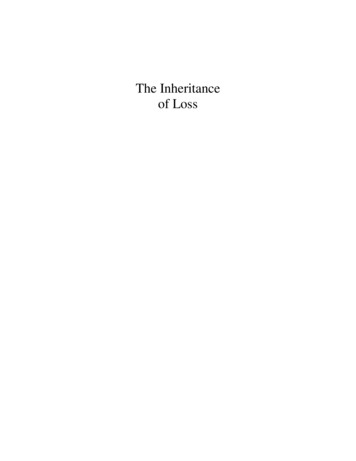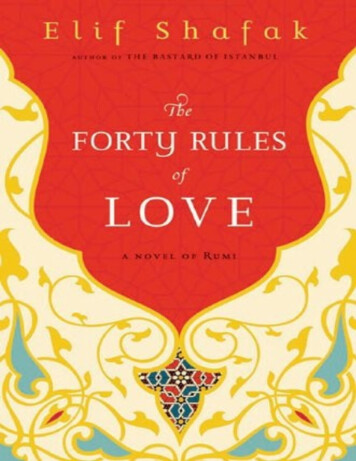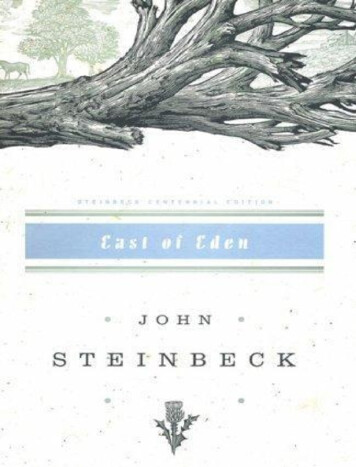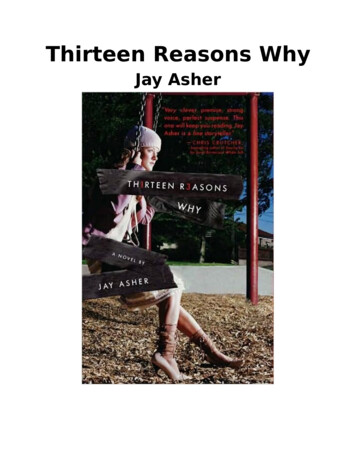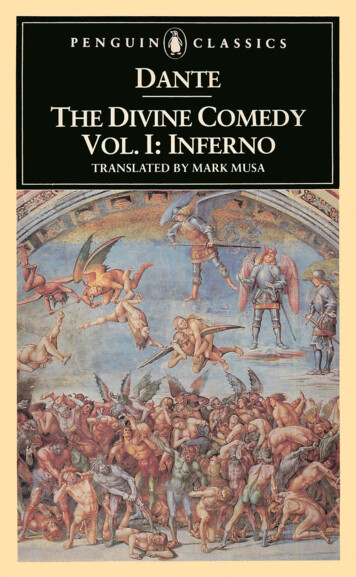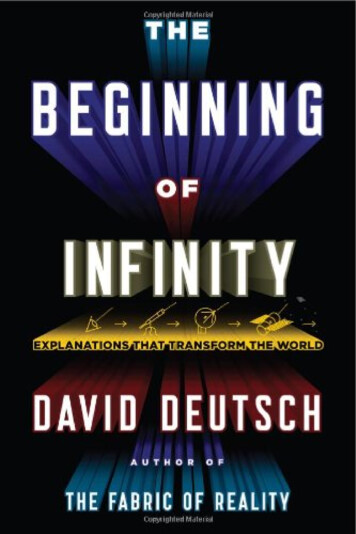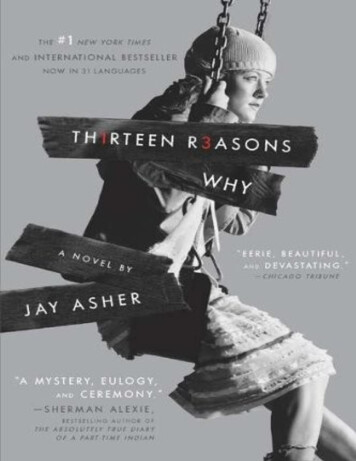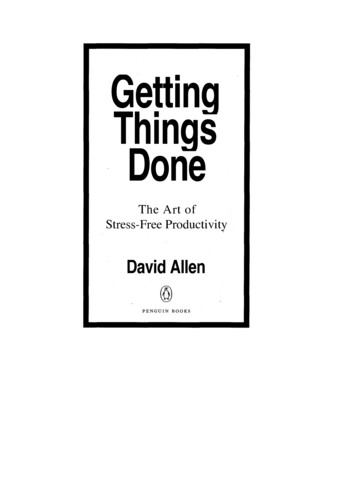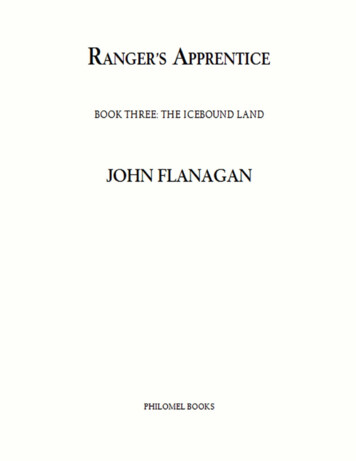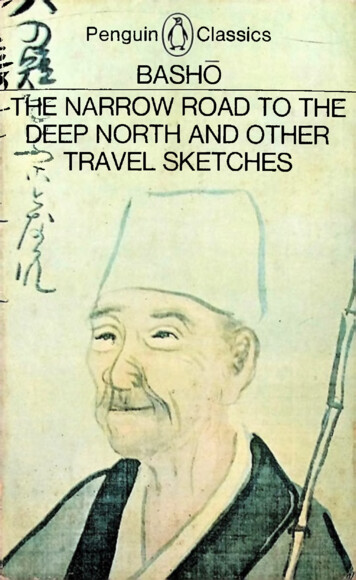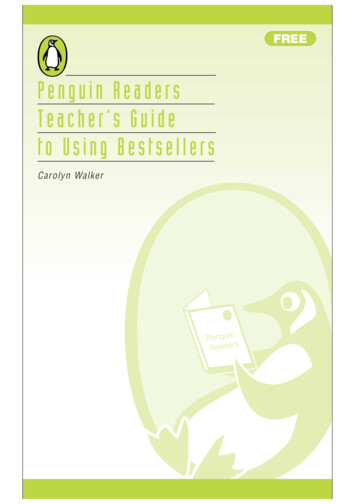
Transcription
FREEPenguin ReadersTeacher’s Guideto Using BestsellersCarolyn Walker
ContentsIntroduction2Penguin’s top 20 Bestselling Graded ReadersLevel 2Level 3Level 4Level 5Why are these books so popular?222334Making use of the Bestsellers list4The library systemDo your students read books for pleasure?Ground rulesEncouraging reading achievementsReading is a social activity55556Class ReadersChoosing a class Reader from the Bestsellers listSome points about managing the readingUnderstanding the bookLanguage practiceResponding to and evaluating the book66771112Scheme of work for a class Reader17Photocopiable Student’s Worksheets1 Are you a bookworm?2 Reading record3 Reading target4 Bestsellers survey5 What would you do if.?6 Arranging in the right order7 What does the future hold?8 Matching9 Was it a good thing or a bad thing?10 Interview a character11 One person’s view of another12 My book from A–Z
1 Introductionpopular children’s story. There is a well-known filmstarring Jenny Agutter, made in 1971, and also a morerecent TV adaptation.Penguin Readers offer teachers and students anextremely valuable resource for learning English and,just as for other types of books, there is now a list of theTop 20 Bestselling Readers. . These are the books whichare consistently popular among students and teachersaround the world.In this Guide you will find the reasons why largenumbers of teachers are making use of the bestsellingPenguin Readers to teach English and why theirstudents are becoming bookworms – in English!This Guide also gives teachers lots of concrete andpractical suggestions on how to maximise the use ofbestsellingGraded Readersso that students get the fullbenefit of extensive reading.Mr Bean is a simply written ‘novelization’ (i.e. a bookbased on a film) of the comedy film, which was releasedin 1997 starring British actor, Rowan Atkinson. In thefilm, the rather strange Mr Bean, familiar to TV viewers,is sent as an ‘art expert’ to a gallery in Los Angeles.While there, Mr Bean accidentally ruins a famousmasterpiece. But somehow he manages to rescue thesituation, earn the gratitude of his host, and evenimpress the art world with his perceptive remarks on themasterpiece. All Mr Bean fans will love this book, andthose unfamiliar with him will find the book highlyentertaining.2 Penguin’s top 20 BestsellingGraded ReadersPenguin’s ‘top twenty’ list for the year 2000, based onglobal sales, was as follows:2.1 Level 2Treasure Island is a classic British story by RobertLouis Stevenson (1883). Treasure Island is a grippingadventure involving pirates, greed and treachery. JimHawkins, the young hero, finds himself on a boat with acollection of rogues sailing to search for buried treasurewhose location is given on a secret map. The story has ahistorical setting, but the excitement and romanceensure its appeal for modern readers. There have beenseveral films made, including one in 1990 starringCharlton Heston.2.2 Level 3White Fang is a classic animal story by US writer JackLondon (1906). White Fang, half wolf–half dog, is foundby Indians in the wild north west of Canada at the timeof the gold rush of the 1890s. The story tells how afierce, wild animal is gradually tamed and civilized as hepasses from one owner to another, and we see howcruelty breeds violence while respect and gentleness arerewarded by love. There have been two film versions ofthe story, the latest by Disney in 1990.Audrey Hepburn is a biography specially written forlearners of English. Overcoming the hardship andpoverty of her youth in Europe, Audrey became afamous Hollywood film star whose career lasted nearlyforty years. Despite her outward success, however, shewas often unhappy, and her personal life was troubled.In later life she worked for the United Nations to helpdeprived children all over the world. This is aninteresting account of the life of a much-loved actress.The Railway Children is a classic story by British writerE. Nesbitt (1906). When their father is mysteriouslytaken away, three children and their mother are forced toleave their comfortable home. The children find interestand excitement in their new life through the trains whichpass by their house every day. Then, after a while thereason for their father’s disappearance comes to light.He has been wrongly accused of a crime, and thechildren are overjoyed when he is released. Theelements of mystery combined with the children’sadventures on the railway line make this an enduringly1Hall, C & M. Coles 1999Children’s Reading ChoicesLondon: Routledge2Princess Diana is a biography of the British princess,specially written for learners of English. As a beautifulyoung girl, Lady Diana Spencer married Prince Charles,the heir to the British throne, in a fairy-tale wedding. Butall was not as it seemed. Privately, the marriage wentwrong early on and Diana developed an eating disorder.In public, she became a colourful member of the Britishroyal family and the public adored her. She won people’shearts, too, through her charity work for theunderprivileged and outcasts of society. Her tragic deathat the age of thirty-six in a car accident shocked theworld. Many people felt as bereaved as if she had beenin their own family. This biography provides a detailedand fascinating account of an important figure in Britishpublic life.Matilda is the highly entertaining and popular children’sstory by British writer, Roald Dahl (1989). In a recent1survey of children’s reading in the UK, Matildawas thesecond most popular book (afterThe BFG, another bookby Roald Dahl). Matilda is an exceptionally clever andunusual little girl, but her awful parents aren’t at allinterested in her, believing that girls don’t neededucating. When she finally gets to school, she finds theterrifying Miss Trunchbull, who terrorises all thechildren. Then Matilda discovers that she can makethings move just with her eyes. With this special power,she is able to take control of her life and take actionagainst the bad adults who mistreat the children in theircare. An excellent film was made of the book in 1996.Forrest Gump is an original story by Winston Groom.Groom’s version showed a satirical view of life in theUSA in which anyone, even an idiot, could become
the ordinary and everyday, and the worries andconcerns of an engaging, likeable and typical teenagergrowing into maturity. Poignantly, the Diary comes toan abrupt end, as the family were discovered andarrested. Only the father survived the concentrationcamps. The Diary was made into a play in 1955, and afilm based on the play came out in 1959.successful and live the ‘American Dream’. But thehugely successful film, which starred Tom Hanks andcame out in 1994, was not really satirical. Forrest Gumpis a warm-hearted but simple man. In the film he tellsus his life story: how he became a university studentand a footballer, a war hero who meets the President, achess player, a wrestler, a businessman and anastronaut. It is a touching and, at the same time, comicstory which makes us re-evaluate intelligence andsuccess.The Client is a thriller by US writer, John Grisham,published in 1993. One day, eleven-year-old Mark, aboy who watches too much TV, sees a violent attacksuch as he has previously seen only on the screen. As aresult, he is now in possession of dangerousinformation. An eccentric lawyer tries to help him as heis caught between the interests of the law and theMafia. Working against time, together they are able towork out how to protect Mark and his family from thepeople who would like to do them harm. This is a fastmoving, exciting book which readers will find hard toput down. A film starring Tommy Lee Jones and SusanSarandon was made in 1994.Amistad is another film novelization. The film wasreleased in 1997. It is based on a true story of a groupof Africans who were kidnapped and shipped across theAtlantic in 1839. Sold as slaves in Cuba, the groupmanages to kill the men in charge of the ship which istaking them to their new ‘owners’. But the ship isstopped by the Americans and the Africans are arrestedand tried for murder. They do not speak English socannot tell their story, and their plight becomesenmeshed with the politics of the time. A young lawyersets out to discover the truth. Through his fight againstprejudice and injustice, the Africans are freed and ableto return home. At the time, the episode attracted muchpublic interest: the US was then divided in two overslavery, an issue which eventually led to a bloody civilwar.2.4 Level 5Four Weddings and a Funeral is a simplifiednovelization of the hugely popular romantic comedyfilm which was released in 1993, starring Hugh Grantand Andie McDowell. The screenplay was written byRichard Curtis, one of the best current British writers ofcomedy and the film began a series of successes forBritish film-making. One of a group of friends, Charles,is a young man in search of love. The trouble is he istoo shy and reticent to get the girl he really loves –Carrie. When she marries someone else, he tries tomake the best of things by nearly getting marriedhimself. Luckily for him, Carrie reappears and all endswell. The story captures a particular type of Englishnesswhich is instantly recognizable, while at the same timetaking a very humorous look at love and relationships.Rain Man is another film novelization. The 1988 film,starring Dustin Hoffman and Tom Cruise, received threeOscars (best picture, best director, best actor). WhenCharlie Babbitt’s father dies, Charlie is furious to findthat his father has left his fortune to an unknownperson. Then Charlie discovers that the money hasgone to a brother, Raymond, that he never knew hehad. But Raymond is autistic. Determined to get hisrightful inheritance, Charlie takes his brother from thespecial home where he lives. In the process Charlieremembers long forgotten facts about his childhood,and that Raymond was the real ‘Rain Man’, who he hadmade into his imaginary friend. Charlie learns to lovehis disabled brother more than money, making this anentertaining but moral tale.The Pelican Brief is another block-busting thriller byJohn Grisham, published in 1992. It is a story of bigbusiness, politics and corruption in high places in theUS. Two Supreme Court judges are murdered at thesame time. Are their deaths a coincidence or is there aconnection? A bright law student, Darby Shaw, decidesto investigate and comes up with a seemingly farfetched theory, which she writes up as a brief. It turnsout that the ‘Pelican Brief’ actually reveals secrets somepeople with connections to the President himself wouldlike to remain hidden. These people are prepared to killand Darby has to go on the run to save her life. As withall Grisham stories, this is a gripping and exciting read.An excellent film came out in 1993 starring JuliaRoberts and Denzel Washington.Braveheart is an original story by American writerRandall Wallace, about a Scottish rebel leader in thethirteenth century. After his beloved wife, Murron, isbrutally murdered by the English, William Wallace killsan English nobleman in revenge and becomes anoutlaw and a rebel. Meanwhile, the English king,Edward I, wants control over Scotland. Wallace, fightingfor his country’s independence, leads his fellow Scotsto victory over the English in several battles andbecomes a national hero. But in the end, Wallace cannotmaintain unity among the other Scottish nobles and atrick results in his capture and execution. The 1995 filmstarring Mel Gibson won an Oscar for Best Picture.Wuthering Heights is the classic British nineteenthcentury romantic novel by Emily Bronte written in 1847.It is a tragic tale of love and revenge which takes placein the wild, remote Yorkshire Moors in England. At thesame time the book contains insights into dysfunctionalfamily life which are relevant today. Heathcliff, a strangefoundling child brought to live with the Earnshawfamily, grows into a passionate youth who falls in lovewith Catherine Earnshaw. But Catherine marries EdgarLinton. Badly treated by the rest of the family, Heathcliffplans his revenge. First, he artfully acquires theproperty of the Earnshaws. Then Catherine dies after2.3 Level 4The Diary of a Young Girl is the famous diary writtenby a young Jewish girl, Anne Frank. The Diary coversthe two years the Frank family spent in hiding from theNazis in part of an office building in Holland from1942–1944. In the Diary, 13-year-old Anne gives a vividaccount of the hardship and fear experienced by thefamily. At the same time – and this is what makes thebook so compelling – she also cheerfully documents3
giving birth to a daughter, and after a while, Heathcliffbegins to find that revenge is not so sweet. Though healso gains the Linton’s property, he is tortured bymemories of his beloved Catherine and is overcome byguilt and madness. There have been many films, thelatest being in 1992 with Juliette Binoche and RalphFiennes.was world famous and interest in her hardly needs anexplanation, while Audrey Hepburn was one of the filmworld’s major female stars and is well known tofilmgoers. Some of the books will have come to people’sattention through the film first, for example, FourWeddings and a Funeral, Amistad, Forrest Gump, RainMan, Braveheart, Mr Bean. All of these films have beenimmensely popular worldwide so it is not surprising thatpeople like to read the book of the film.The Prisoner of Zenda is a classic nineteenth centuryadventure story by Anthony Hope written in 1894. Thisbook was Hope’s most successful and established himas one of the most popular writers of his time. It is setin an imaginary country, Ruritania, and the hero, RudolfRassendyll, is everything a hero should be: skilful,quick-witted, handsome and courageous. On visitingRuritania, he discovers that he looks just like its newking. Circumstances result in him having to play the partof the king while the real king is held captive in thecastle at Zenda. It’s a risky game that Rudolf is playing –not least because he falls in love with the beautifulPrincess Flavia. In true heroic tradition, however, herescues the king and returns home broken-hearted, butwith his honour as a gentleman intact. The story hasbeen made into a film several times, most recently in1979 with Peter Sellers.ClassicsSome bestsellers are simplified versions of extremelywell-known classic works of fiction. These include WhiteFang, Treasure Island, Wuthering Heights, The RailwayChildren, The Prisoner of Zenda. Anne Frank, though notfiction of course, is one of the best-known and mostwidely read books in the world.Bestselling writersThere are five books on the bestsellers list by three ofthe world’s bestselling contemporary writers in English:Roald Dahl, John Grisham and Stephen King. Dahl isone of the most popular children’s writers ever: hisbooks are consistently at the top of current children’slists of favourites. Grisham’s and King’s books are easyto read and very exciting.The Firm is John Grisham’s first successful thriller,published in 1991. It is set in the murky world of theMafia and the law. Mitchell McDeere is a talented younglawyer who gets himself a top job in Memphis, USA. Buthis new law firm has some odd customs and severalpast employees have died in strange circumstances.When the FBI approach Mitchell and tell him about hisbosses’ real business – money laundering for the Mafia– he must decide whether to help the FBI and risk hislife, or to keep quiet and eventually be arrested forcriminal activities. He chooses the former. There thenfollows an exciting chain of events as Mitchell gets theevidence which the FBI need, and manages to escapethe clutches of the Mafia. The film, with Tom Cruise,Gene Hackman and Holly Hunter, came out in 1993.Fact or fiction?It is sometimes suggested that some people (often malereaders) prefer to read factual material rather thanfiction. It is noticeable, however, that these bestsellersare mainly fiction. The three books which are not fictionare biographical.Simplifications or specially devised stories?Sometimes the value of simplifying original works isquestioned. However, in the bestsellers list, the onlybooks which are not simplifications of originals are thebiographical Princess Diana and Audrey Hepburn.What can we conclude from all this? Mainly, it seemslikely that people may choose to read something theyhave already heard of or know something about. Thefilm or the book itself may be well known, or perhapsthe writer or individual concerned is well known. Inparticular, films would seem to have a very significantmotivating effect on reading. Moreover, it seems clearthat reading a simplified version of an original is anenjoyable experience for many learners. These points arevery important when it comes to choosing books whichwill be suitable for students and which they will want toread.The Body is a short novel by Stephen King published in1982. King is mainly known for his horror stories, manyof which have been made into very popular films (suchas The Shining). But this is a tale of growing up inmodern America. Four boys aged about thirteen set offsecretly to find the body of another young boy who, theyhave heard, has been found some way from where theylive. Seeing a real dead body seems to them to be animportant and daring thing to do. The story explores therelationship between the four, and is presented by thenarrator as an attempt to account for how he managedin later life to leave behind the poverty and ignorance ofhis upbringing, while his friends were not so lucky. Thisis a skilful account of four working class boys on theedge of adulthood. A film of the story called Stand byme was made in 1986 with River Phoenix.3 Making use of theBestsellers listThere are two main ways in which graded Readers areused: In a library system: a selection of books at the rightlevel for the class is assembled to make a classlibrary. Or the full range of levels in a school may becatered for in the school library or study centre.Using the library system, students withdraw a bookappropriate for their level on a regular basis orwhenever they wish. Students can read their books inclass in a ‘quiet reading session’, or at home forhomework. The teacher will probably see each2.5 Why are these books so popular?There are a number of different reasons why thesebooks are so popular:FilmsThere are films of all of the bestsellers except two(Princess Diana and Audrey Hepburn), and most of thefilms have been released in the recent past. Of thepeople in the two books without films, Princess Diana4
habits. Once you know whether your students read forpleasure in their own language, what their attitudes toreading are, and what sorts of things they read, you canbuild motivation for reading in the foreign language byproviding similar material. Student's Worksheet 1 willalso enable you to see what genres of books studentswill like from this Bestsellers list (see Section 5.1below). An important factor in maintaining motivationmust be having books in your library that your studentswill want to read and will be able to read.student individually to discuss the book which isbeing read. The book may or may not have anaccompanying activity sheet. Teachers may askstudents to write ‘reading diaries’ so that a record ofthe reading is kept (see Section 4.4 overleaf).The advantages of the library system are that,because it operates on a self-access basis, studentscan control what they read, when and where theyread, and how much they read. The library systemoffers the opportunity for ‘pleasure reading’ in theforeign language and is a means for ‘usefulrelaxation’.As class Readers: the teacher, or the teachertogether with the students, chooses a book at theright level for the class, and everyone has a copy toread. Students can do the reading at home or inclass, either individually or as shared or groupreading. Exercises and activities for class work arebased on the class Reader (see Section 5 below).The advantages of a class Reader are that thewhole class reads the same text and so teachers cankeep a check on how much reading is being done.The class Reader can naturally form part of a readingsyllabus, and acts as a stimulus for class activities. Itcan be a focus for vocabulary extension work,grammar or pronunciation practice.It is important that both these ways of usinggraded Readers should be seen as complementary,not mutually exclusive. Using a class Reader can actas a motivation for students to go to the library andfind more books to read on their own. The workdone in class on a Reader can help students feelconfident about approaching a book of their ownchoosing.The Bestsellers list is clearly a useful source ofreference for choosing books to be used in boththese systems.4.2 Ground rulesGiving clear ‘ground rules’ for reading in the librarysystem will help to make sure that students really doread. For example: Set reading targets. Tell students that they must readone book per week, or X number of books per termor semester, and that when they have read ten booksat one level they can try the next level. Paul Nationhas calculated that to maximise the vocabularylearning benefits of graded Readers, students at theintermediate level should read about one book perweek2. (Note that, if we take one book per week as abaseline, it is likely to be at least six months beforestudents’ efforts will start to see some reward.) Make sure students know that if they don’t like theirbook, they don’t need to finish it, but should changeit as soon as possible. Ensure that students keep a reading diary, which youshould check from time to time. Student'sWorksheet 2 can be used for this purpose. Set the tasks in the back of the Reader as part of theextensive reading assignment. Alternatively, use thetasks and exercises in the Penguin ReadersFactsheets, which accompany the books. Hold regular reading tutorials with each student todiscuss his or her reading programme and checktheir reading diary. In the tutorial, ask for students’opinions about the books they have read, giveencouragement to keep reading, help students tochoose appropriate books, make suggestions forother titles or types of books, ask students abouttheir reading strategies and suggest alternativestrategies, listen to students reading a little of thetext aloud (suitable at lower levels), etc.4 The library systemGuidance on setting up libraries and introducingstudents to extensive reading is given in the PenguinReaders Teacher’s Guide to Using Graded Readers.Some additional considerations are given below,relating particularly to building and maintainingmotivation for reading extensively in a library system.4.3 Encouraging reading achievements Use a ‘rewards’ system. If you work in a school, thiscan be tied in with the school system. For example, ifa student reads ten books he/she will get a ‘housepoint’, or a ‘well done’ stamp. Where assessmentsare made, give students a higher grade if they read acertain number of books, a lower grade for fewerbooks, etc. In addition to the diary referred to above, getstudents to keep lists of the books they have read.Set targets for each individual. Again the Bestsellerslist will be useful here. Tell students that their targetis to read all the books on the list. They can useStudent's Worksheet 3 to record the books theyhave read. When the target is full, give anappropriate reward. This will encourage students tofeel pleased with their reading achievements.4.1 Do your students read books for pleasure?Unfortunately, reading books for pleasure (in the firstlanguage) is not something that everybody does,though other types of reading (newspapers, magazines,Internet, etc) may take place. Even in places whereschool children do read a lot, especially in the earlyyears of learning to read, once they reach adolescence,there are other activities which start to take up theirattention, so that by the time they are adults they mayhave lost the reading habit. So it is not enough simplyto place a library of books at the students’ disposal.They may need to be strongly encouraged to read thebooks as well.Use Student's Worksheet 1 to find out what yourstudents’ attitudes to reading are outside school. Isreading for pleasure something they do or not? UseStudent's Worksheet 1 as a way of discussing reading2Nation, P. ‘The Language Learning Benefits of Extensive Reading’. The Language Teacher t/97/may/benefits.html (as at 5.11.01)5
4.4 Reading is a social activityAlthough the act of reading is done by each individualon his or her own, in fact reading is firmly rooted withina community. Reading is an activity (like any other)which we have in common with our peers. We readbooks recommended by our friends or family, forexample. We may read a book because someone weadmire has read it. Perhaps a book has becomefashionable or it has received a lot of publicity, or it hasrecently come out as a film or TV series. Many peoplechoose the books they read by looking at thebestsellers lists in newspapers. All of this is evidence ofthe ‘reading community’ in a particular society. In thesame way, the Penguin Bestsellers list is evidence of acommunity of readers learning English.Thus, encouraging a ‘reading community’ amongstyour learners is an important aspect of building andmaintaining motivation for pleasure reading. Somesuggestions for ways of doing this are: Holding competitions. Try a ‘reading race’ – the firstperson to complete their target, or read, say, twentybooks will win a prize. Or the person who has readthe most books in a given period wins a prize. Hold ‘book afternoons’ or out of school ‘clubs’ inwhich each student brings their favourite book andexplains why they liked it. The afternoons could be‘themed’, for example, the books could be limited tobooks of films, or to thrillers, or the classics, orbooks by one writer. Students could bring an objector a picture which symbolizes something theyparticularly liked in their favourite book – otherstudents then try to guess which book the objectrelates to. Younger students may like to dress up astheir favourite character. Set up a role-play activity inpairs in which Student A is a film scriptwriter whohas written the story. The writer wants to sell thestory to Student B, who is a film producer. The filmproducer will only buy the film script if it sounds likea good story, so Student A must tell it well. Use Student's Worksheet 4 to find the class orgroup’s ‘top ten’ books from the Bestsellers list, asfollows: 5 Class ReadersAs we have already said, the library system and classReaders should ideally act in a complementary way,each one ensuring that students read extensively andoffering different kinds of support for the learning andreading processes.So that students derive the maximum benefit of theirexperience with the book, the aim of class work on aclass Reader should be to:1 organize and monitor the reading of the book2 help students to understand the book3 enable students to learn and practise relevantaspects of language4 enable students to respond to and evaluate the bookThe Penguin Teacher’s Guide to Using Graded Readersgives guidance and advice on introducing a Reader andusing it with students. Some additional considerationsare given in Sections 5.1 and 5.2 below.There are, in addition, a large number of useful andenjoyable activities based on a Reader which can bedone in the classroom. Look at the other Teacher’sGuides in the series produced by Penguin and at theFactsheets.In the meantime, Sections 5.3–5.5 of this Guidedescribe many such activities, grouped for easyreference according to exercise type and the aims ofclass work on a Reader given above. Examples aregiven of how some of the activities might be used withthe books on the Bestsellers list.Finally in Section 6 there is a scheme of work for aclass Reader over six lessons.1 This Worksheet can be done towards the endof the year or term.2 Tell students to write down as many of theBestsellers as they have read and give thema rating. If students cannot write twentytitles, tell them to write as many as they can.3 Find the class’s ten most frequentlymentioned books.4 In order to arrange these books in a final list,decide with students whether the number ofmentions is the most important criterion, orwhether rating is more important.5 Then write the list on a large sheet of paperfor display in the library or classroom. Website; or display the summaries and reviews inthe library.To help make sure that the graded Readers section inthe library or study centre looks attractive, makeenlarged photocopies of quotations from the bookreviews and put them on the wall. Advertise newacquisitions with photos or pictures. Get postersfrom films and put on them on the wall, attachingthe comment ‘Seen the film? Now read the book!’Put up on the wall the list of the school/class top tenor twenty favourites. Put up the Penguin list ofbestselling titles.5.1 Choosing a class Reader from theBestsellers listThe Bestsellers list offers teachers an easy way toselect a book which students will enjoy. You canobviously make a decision on the choice of bookyourself but it is a good idea to use students’ ideas tohelp make the decision. For example: Show the previous class’s top ten books to the nextclass to help them choose their books.Set tasks such as book reviews or summaries forhomework and ‘publish’ the best pieces, for example,in the school magazine, newsletter or on the school6Use information from Student's Worksheet 1 andStudent's Worksheet 5 to find out what genres andtopics students like best to help you narrow downyour choices or actually make your decision. Belowis a guide to how the Bestsellers fit the genres/topicsgiven on Student's Worksheet 1:
a LOVE AND ROMANCE – The Horse Whisperer,Four Weddings and a Funeral, WutheringHeightsb UNUSUAL PEOPLE – Forrest Gump, Rain Man,The Horse Whisperer, Mr Beanc ADVENTURE – Tr
Understanding the book 7 Language practice 11 Responding to and evaluating the book 12 Scheme of work for a class Reader 17 Photocopiable Student's Worksheets . London (1906). White Fang, half wolf-half dog, is found by Indians in the wild north west of Canada at the time of the gold rush of the 1890s. The story tells how a
